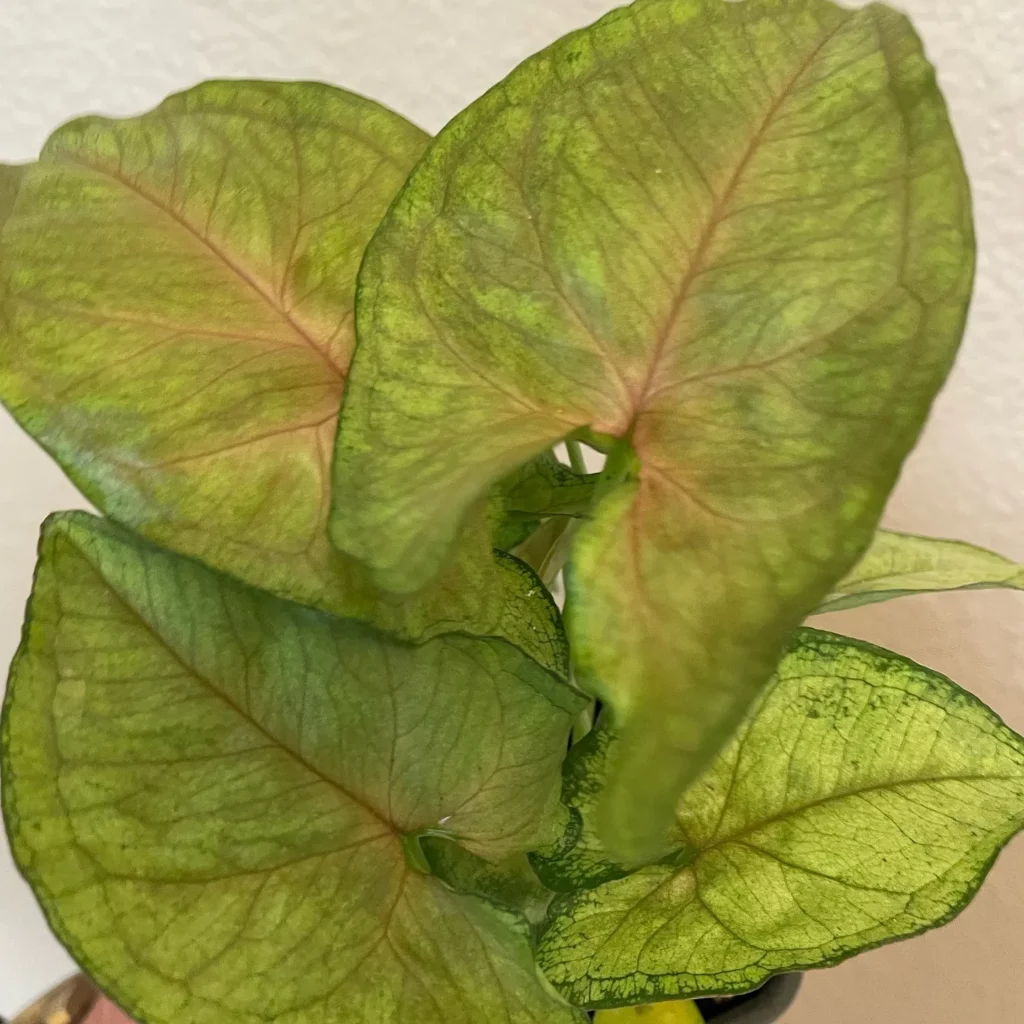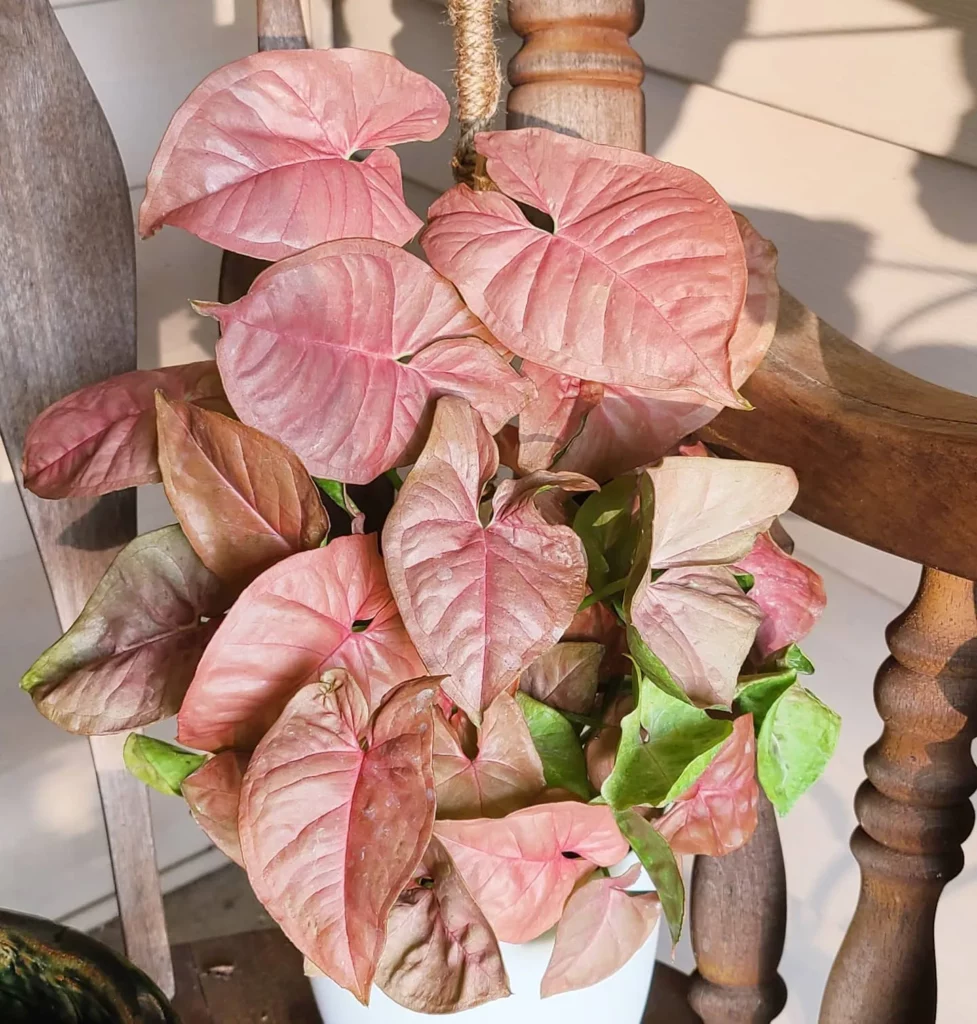The Arrowhead Plant, also known as Syngonium podophyllum, is a stunning houseplant appreciated for its vibrant leaves. Its arrowhead-shaped leaves come in a variety of colors, including green, white, and pink. This plant grows as a vine, making it a popular choice for hanging baskets or trailing from shelves.
No products found.
Understanding the Appearance of Arrowhead Plant

With its variegated leaves and vine-like growth, the Arrowhead Plant adds a touch of elegance and natural beauty to any indoor space. The contrasting shades and patterns on its foliage create a visually pleasing display, making it a standout feature in your home or office.
The leaves of the Arrowhead Plant vary in size, ranging from small and delicate to larger and more robust. They have a heart-shaped base and a pointed tip, mimicking the shape of an arrowhead, hence its common name.
Variegated Leaves
One of the most alluring characteristics of the Arrowhead Plant is its variegated leaves. Some varieties boast striking variegation, with intricate patterns of white, cream, or pink splashed across the green foliage. This marbled effect adds depth and visual interest to the plant, making it a real eye-catcher.
- Variegated leaves feature patches, streaks, or speckles of different colors.
- Common variegation patterns include mottled, spotted, or striped.
- The intensity of variegation can vary, with some leaves having a more pronounced contrast between colors.
Vine-like Growth
No products found.
As a vine, the Arrowhead Plant has a trailing growth habit that allows it to gracefully cascade from hanging baskets or climb up trellises and moss poles. This versatile plant adapts well to its surroundings, making it an excellent addition to your indoor garden or as a decorative accent in any room.
No products found.
The vine-like growth pattern of the Arrowhead Plant provides versatility in styling options. You can train it to climb or allow it to beautifully drape over shelves, creating a natural, green curtain effect.
- The long and slender stems of the Arrowhead Plant produce aerial roots, aiding its climbing abilities.
- It responds well to pruning, allowing you to shape and control its growth according to your preference.
- The flexible nature of the plant’s stems enables it to adapt and thrive in various light conditions.
No products found.
Meeting the Light Requirements of Your Arrowhead Plant

To ensure the optimal growth of your Arrowhead Plant, it requires bright, indirect light. Direct sunlight can be too intense and potentially scorch the leaves, so it’s best to avoid exposing your plant to it. Instead, place your Arrowhead Plant in a well-lit room with plenty of natural light.
When choosing a spot for your plant, make sure it’s away from windows with direct sun exposure. This way, you can provide the bright indirect light that your Arrowhead Plant needs without subjecting it to harmful rays. If your living space has limited natural light, you can also supplement it with artificial grow lights.
No products found.
Here are the key points for meeting the light requirements of your Arrowhead Plant:
- Provide bright, indirect light
- Avoid direct sunlight to prevent leaf scorching
- Place your plant in a well-lit room
- If necessary, use artificial grow lights
Watering Your Arrowhead Plant: Best Practices

Proper watering is crucial for the health of your Arrowhead Plant. Follow these best practices to ensure your plant thrives:
- Keep the soil consistently moist but not waterlogged. Arrowhead Plants prefer moist soil, but excess water can lead to root rot.
- Allow the top inch of soil to dry between waterings. This ensures that the roots have enough oxygen and helps prevent overwatering.
- Take humidity levels into account when watering. If the air is dry, you may need to water more frequently to compensate.
- Adjust your watering schedule based on the specific needs of your plant. Factors such as the size of the pot and the ambient temperature can affect water requirements.
- Check the moisture level of the soil by inserting your finger about an inch deep. If it feels dry at that depth, it’s time to water.
- Use room temperature water when watering your Arrowhead Plant. Cold water can shock the roots.
- Avoid using tap water if it is high in minerals. Use filtered or distilled water instead to prevent mineral buildup in the soil.
- Consider using a well-draining potting mix to ensure excess water can easily drain away.
Fertilizing Your Arrowhead Plant: Nourishing Growth

The Arrowhead Plant is a beautiful houseplant that thrives with regular fertilization. By providing the right nutrients, you can support its healthy growth and vibrant foliage. Fertilizing your Arrowhead Plant during the growing season is essential to ensure its nutritional needs are met. A balanced houseplant fertilizer is ideal for this purpose.
No products found.
During the active growth period, typically in spring and summer, use a balanced fertilizer specifically formulated for houseplants. Check the product instructions for the recommended amount to apply. Applying too much fertilizer can be harmful, so it’s important to follow the instructions and avoid overfeeding.
Reduce or stop fertilizing your Arrowhead Plant during the winter months when its growth slows down. This allows the plant to enter a dormant phase and conserve its energy. However, continue to monitor its nutrient requirements and resume fertilization in early spring when new growth begins to emerge.
Potting Your Arrowhead Plant: Choosing the Right Container

When potting or repotting your Arrowhead Plant, it’s important to select a suitable container that promotes healthy growth. Choosing the right container involves considering factors such as proper drainage, adequate space, and the type of soil your plant requires.
A key consideration is ensuring the container allows for proper drainage. Excess water in the soil can lead to root rot and other issues, so it’s crucial to select a container with drainage holes at the bottom. This allows excess water to escape and prevents waterlogging.
Equally important is the choice of a well-draining potting mix. Arrowhead Plants thrive in soil that provides good aeration and allows water to flow through easily. Look for a potting mix specifically formulated for indoor plants or create your own mixture using equal parts peat moss, perlite, and potting soil.
When selecting a pot, opt for one that is slightly larger than the current container. Arrowhead Plants prefer to be slightly root-bound, so a pot with a little extra room will allow for growth without overwhelming the plant. However, avoid choosing a pot that is too large, as excessive soil can retain too much water and potentially harm the roots.
Regularly check for root congestion by gently lifting the plant from its container. If you notice an excessive amount of roots or the plant has become root-bound, it’s time to repot. Repotting is typically done every one to two years to provide fresh soil and adequate space for the plant to grow.
Propagating Your Arrowhead Plant: Expanding Your Collection

Propagating your Arrowhead Plant is a rewarding way to grow new plants and expand your collection. Whether you prefer stem cuttings or division, there are multiple methods to successfully propagate your Arrowhead Plant.
Stem Cuttings
One popular method of propagation is through stem cuttings. Here’s how to do it:
- Select a healthy stem from your Arrowhead Plant.
- Using clean, sharp scissors or pruners, cut a section of the stem just below a leaf node.
- Remove the lower leaves to leave a few inches of bare stem
- Place the cutting in a glass of water or directly in moist potting soil.
- Keep the cutting in a warm, well-lit area, away from direct sunlight.
- Change the water every few days if using the water propagation method.
- After a few weeks, roots will start to form, and new growth will appear.
- Once the roots are well established, you can transfer the cutting to a pot or container with well-draining soil.
Division
Division is another method you can use to propagate your Arrowhead Plant. Here’s how to do it:
- Carefully remove the Arrowhead Plant from its pot.
- Gently separate the plant into two or more sections, ensuring each section has healthy roots and shoots.
- Trim any damaged or excessive roots.
- Repot each divided section into its own container filled with well-draining soil.
- Water the newly potted sections thoroughly and place them in a warm, well-lit area.
- Continue to care for the divided sections as you would for a mature Arrowhead Plant.
Growth and Development of Arrowhead Plant

The Arrowhead Plant is well-known for its vigorous vine growth, which adds a captivating touch to any indoor space. Understanding how to manage and support this growth is essential for keeping your plant healthy and vibrant.
Pruning for Compact and Bushier Shape
Regular pruning is key to maintaining a compact and bushier shape for your Arrowhead Plant. By removing unwanted stems, you can redirect the plant’s energy towards healthy growth and encourage branching. To ensure clean cuts, use sharp scissors or pruners and sanitize them before each use to prevent the spread of diseases.
Supporting Growth with Trellis or Moss Pole
Consider providing a trellis or moss pole for your Arrowhead Plant to climb on. This not only supports its natural growth pattern but also adds visual interest to your space. Place the trellis or moss pole in the pot, ensuring it is firmly anchored, and gently guide the plant as it grows.
Benefits of Supporting Growth
Supporting the growth of your Arrowhead Plant through pruning and providing a trellis or moss pole offers several benefits. Firstly, it helps maintain an aesthetically pleasing shape, preventing the plant from becoming leggy or unruly. Secondly, it encourages the plant to produce more foliage, giving it a fuller and healthier appearance.
- Regular pruning keeps the plant compact and bushy.
- Using a trellis or moss pole supports the plant’s natural growth pattern.
- Pruning and supporting growth result in a fuller and healthier appearance.
Dealing with Pests and Diseases: Keeping Your Arrowhead Plant Healthy

Just like any other houseplant, your beloved Arrowhead Plant can be at risk of pesky pests that can hinder its growth and health. Common pests to watch out for include spider mites, mealybugs, and aphids.
Regularly inspect your plant for signs of infestation, such as webbing, tiny insects, or sticky residue on the leaves. If you spot any pests, take swift action to eliminate them and prevent further damage to your plant.
In addition to pests, your Arrowhead Plant may also be susceptible to common plant diseases like root rot and leaf spot. To prevent these diseases, ensure proper watering practices by allowing the top inch of soil to dry out between waterings.
Overwatering can lead to root rot, so it’s crucial to find the right balance. Avoid wetting the foliage as this can promote leaf spot disease. Proper air circulation and maintaining a clean environment around your plant can also help prevent disease development.
No products found.
If you notice any signs of pests or diseases on your Arrowhead Plant, it’s important to take immediate action to protect its health. Treat affected areas by using organic solutions like neem oil or insecticidal soap for pests.
For diseases, prune and remove infected foliage, providing optimal growing conditions and allowing your plant to recover. Remember, a vigilant eye and proactive measures are key to keeping your Arrowhead Plant thriving and pest-free.
FAQ
How often should I water my Arrowhead Plant?
It’s important to keep the soil consistently moist but not waterlogged. Allow the top inch of the soil to dry between waterings. Adjust your watering schedule based on the humidity levels and the specific needs of your plant.
What kind of light does an Arrowhead Plant need?
Arrowhead Plants thrive in bright, indirect light. Avoid exposing them to direct sunlight, as it can scorch the leaves. Place your plant in a well-lit room, away from windows with direct sun exposure. Artificial grow lights can also be used if natural light is limited.
How do I fertilize my Arrowhead Plant?
Regularly fertilize your Arrowhead Plant with a balanced houseplant fertilizer during the growing season, typically spring and summer. Follow the product instructions for the correct dosage. Reduce or stop fertilizing during the winter months when the plant’s growth slows down.
How do I propagate an Arrowhead Plant?
Arrowhead Plants can be propagated through stem cuttings or division. Stem cuttings can be rooted in water or directly in soil, while division involves separating the plant into smaller sections. With patience and proper care, you can successfully propagate your Arrowhead Plant.
How should I pot my Arrowhead Plant?
When potting or repotting your Arrowhead Plant, choose a container with proper drainage. Use a well-draining potting mix with good aeration. Select a pot slightly larger than the current one, as these plants like to be slightly root-bound. Check for root congestion regularly and repot as needed.
How do I support the growth of my Arrowhead Plant?
The Arrowhead Plant has a vine-like growth pattern and can benefit from a trellis or moss pole for support. This helps maintain its natural growth and prevents the plant from sprawling. Regular pruning with clean, sharp scissors or pruners will also promote a compact and bushier shape.
What pests and diseases should I watch out for with my Arrowhead Plant?
Common pests that can affect Arrowhead Plants include spider mites, mealybugs, and aphids. Regularly inspect your plant for signs of infestation and take appropriate measures to eliminate these pests. Additionally, be mindful of plant diseases such as root rot and leaf spot, and address any issues promptly to keep your Arrowhead Plant healthy.





